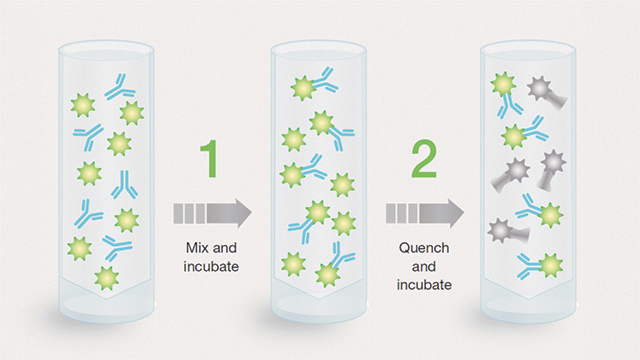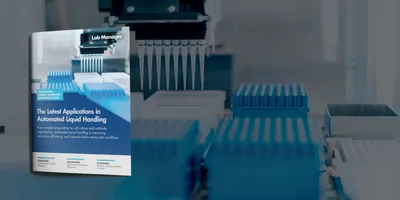 ReadiLink antibody labeling kits use quenchers for in-house fluorescent labeling, removing the need for purification.
ReadiLink antibody labeling kits use quenchers for in-house fluorescent labeling, removing the need for purification.
Problem: Cellular protein detection and quantification can be achieved by a variety of techniques that all require attaching fluorescent labels, or tags, to antibodies. The main challenge with current column-based techniques for antibody labeling lies in the lengthy, hands-on time needed to purify the sample which also results in variation of the quality of the final product.
Tagging antibodies in-house typically requires two steps. First, the fluorescent label is chemically attached to the antibody via a covalent bond using an amine-reactive succinimidyl ester. The fluorescent label is in excess in solution to ensure that all antibodies are labeled. Next, the unbound dye is removed.
Scientists have traditionally used column chromatography to separate the free dye from labeled antibodies. This step not only requires a lot of time and material, but also results in lower yield and greater batch-to-batch variability.
To get around this problem, researchers can purchase pre-labeled antibodies, which are ideal for antibodies against common targets such as PD-1 and CTLA4. However, when working with novel targets, these are hard to find. Pre-labeled antibodies also have a shorter shelf life, which poses an additional problem as each new batch has to be validated to ensure sensitivity and specificity in a time-consuming endeavor.
Solution: Companies are introducing columnfree antibody labeling kits that can be used in place of traditional, labor-intensive column-based methods. These kits eliminate the need for column (or spin) purification by adding quench buffer to the mixture. This quencher binds to the free dye molecules, and removes their ability to fluoresce, thereby eliminating the need to remove it from solution. This approach eliminates the need for a purification step, reducing hands-on time.
Solutions like Bio-Rad’s ReadiLink Antibody Labeling kits now allow scientists to conveniently and reliably label antibodies with consistency, sensitivity, and specificity without compromising on yield. ReadiLink offers an easy and efficient workflow:
1. Suspend the antibody in phosphate-buffered saline
2. Add the reaction buffer
3. Add the labeling dye
4. Incubate for one hour at room temperature
5. Add the quencher
6. Incubate for ten minutes at room temperature
Once the workflow is complete, the antibodies are immediately ready for use in flow cytometry, Western blotting, immunohistochemistry, and cell imaging. Column-free labeling kits can come in a range of excitation and emission wavelength combinations. This gives researchers the flexibility to match the fluorescently tagged antibodies with their cytometer’s light source, detector, and filters, and it also allows them to accommodate multi-color assay panels. The ReadiLink kits, for example, are available in 13 different excitation and emission wavelength combinations.
These new dye kits are ideal for researchers who are currently labeling antibodies as well as scientists who are labeling their antibodies for the first time.
For more information, please visit bio-rad.com/readilink1.












